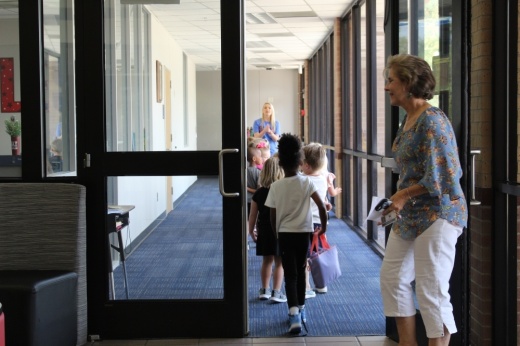In a nutshell
CCISD has seen a decline in enrollment of 2,200 students since 2020, with an additional expected loss of 1,700 students by the 2027-28 school year, according to district documents.
Chief Communications Officer Elaina Polsen said in an email April 8 the reason for the decline is due to the district’s school boundaries being built out, meaning the rate of new neighborhoods is lower than it was 10 years ago. Polsen also said the district is “graduating more seniors than [they] have kindergarteners.”
These enrollment issues have also caused financial challenges within the district ahead of fiscal year 2024-25, according to district officials.
The state of Texas’s basic allotment per student in attendance is $6,160, which has remained the same since 2019. As a result, losing students results in less legislative funding, which has created budgetary challenges, according to district documents.
With the next legislative session not taking place until 2025, it will be at least another year until the state could increase the student allotment or provide other public school funding, according to district documents.
“Dropping enrollment—when school districts are funded based on enrollment in attendance, it’s very difficult to budget, quite frankly, because your numbers are just not generating the funding you may need,” CCISD’s Chief Financial Officer Alice Benzaia said at the district’s March 4 workshop meeting.
By the numbers
Since the 2019-20 school year, the district has seen an increase in a little over 850 students in the special education program, and an increase of a little over 220 students in the bilingual program, according to district documents. This calls for the need for the district to provide more funding for staffing due to the growth of these programs.
Polsen said there are a number of solutions being implemented to resolve the district’s enrollment challenge. She said the district has expanded full-day prekindergarten on a tuition basis, generating about 400 new students for the upcoming school year.
The district has also launched a limited open enrollment program for federal employees and peace officers who live within 10 miles of the district, and have allowed them to bring their children into CCISD through an online application process.
This is because Polsen said the district has seen trends of people living in their homes beyond the time their children graduate high school. This allows these residents to bring their grandchildren who reside outside the district into its neighborhood schools, Polsen said in an email.
Also of note
In regard to enrollment, Polsen mentioned housing as a contributing factor. She said while the district’s enrollment growth from new neighborhoods is slowing down, there is growth in the League City area, near Campbell Elementary and Mossman Elementary.
According to Zonda Education, CCISD’s enrollment declined by 655 students this fall. This is due to higher interest rates negatively impacting the housing market, along with increased charter, private and homeschooling options, officials said.
Groundwork is currently underway on about 215 lots across the district, and the district is expected to add 300‐500 new homes annually over the next two to three years, according to Zonda Education.
The background
CCISD’s tuition-based pre-K program started over a decade ago, said Abbey Sickorez, assistant director for CCISD’s Early Learning department.
CCISD serves 938 pre-K students across 20 elementary campuses with more than 180 of these students currently attending through the tuition-based program, according to agenda documents.
The tuition-based program provides “foundational learning” in language and literacy, math, science, social studies, fine arts, physical development and technology, according to district documents.
The plan was made by CCISD’s Vision 2030 team to offer “quality early education” to all district families.
Sickorez said the main evolution with the tuition-based pre-K program is being able to expand it throughout the entire district based on the recent increased interest in it. Originally, the district could only give away spots from the space they had available, causing the district to have to make sure to leave space for the pre-K qualifying families, Sickorez said.
Officials announced in 2023 plans to expand the pre-K program, Community Impact previously reported.
With 400 new incoming students for the tuition-based pre-K program, CCISD has approved staff openings of 16 teachers and 16 paraprofessionals at its March 26 board meeting. This expansion will cost a little more than $1.6 million and will be funded by the updated yearly tuition rate of $6,000, according to agenda documents.
Additionally, in the 2024-25 school year, all 27 elementary schools will offer prekindergarten, Polsen said in an email.
What they said
Polsen said despite the lack of large enrollment growth, she still sees the district as a desirable place for students to attend based on demographics.
“While Clear Creek ISD is not growing at rapid pace like it once did, we do know families choose Clear Creek ISD considering 90% of school-aged children who live within the district attend their neighborhood public schools,” Polsen said in an email.
Sickorez said she believes the tuition-based pre-K program not only boosts the district’s enrollment, but it boosts students to get a further step ahead in their education.
“I would recommend a tuition pre-K program to all districts,” Sickorez said. “Having impact and having that focus in giving early intervention to our students I think is a win-win. The more we can learn about our kiddos before they really start that kindergarten school year, the better we are to equip them for the future.”
Stay tuned
While applications for CCISD’s tuition-based pre-K program are closed for the 2024-25 school year, open enrollment is available for the district’s nontuition based pre-K program and kindergarten starting April 15.
More information about the enrollment process could be found on the district’s website.





